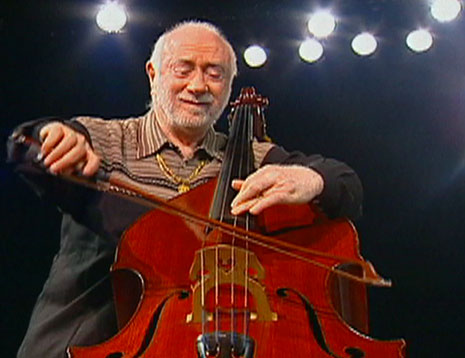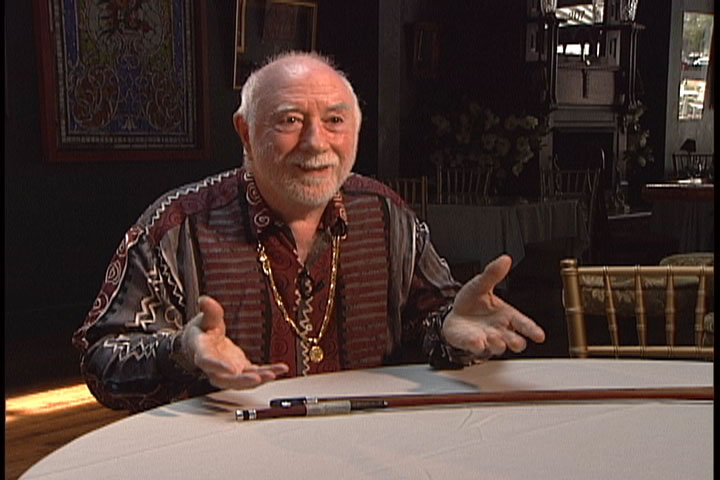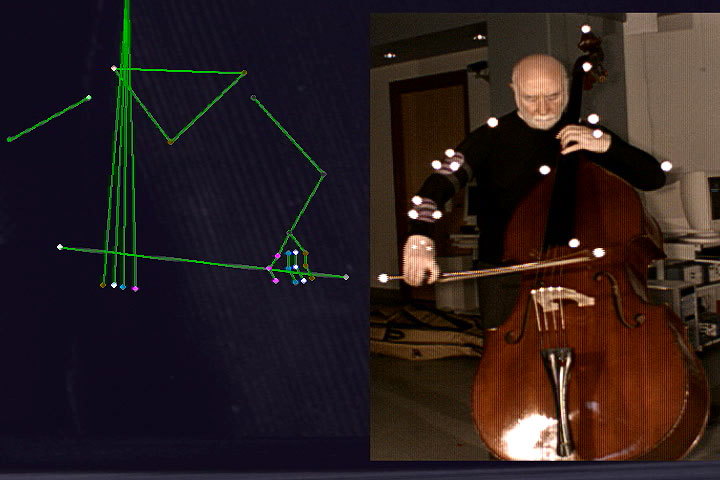The Art of The Bow
- François Rabbath -
 |
|
Cap.01 - Essentials |
| |
Cap. 02 - The Bow Arm |
| |
Cap. 03 - Lessons |
| |
Cap. 04 - Interviews |
| |
Cap. 05 - Multi Angle Video |
| |
Cap. 06 - Biomechanics |
| |
|
| |
|
| |
|
|
|
| |
|
The Art of the Bow project is the first in-depth pedagogical study of a major concert artist utilizing state-of-the-art technology. While past research has been limited to commentary enhanced with print illustrations or single camera video, The Art of the Bow employs multiple camera angles, biomechanics, and the technology of motion capture to offer the most complete picture of the elusive art of bow control currently possible. This project represents a milestone string players a rare glimpse into the subtle art of his bow technique.
 The first portion of the DVD is comprised of four sections; Essentials, The Bow Arm, Lessons, and Interviews. Essentials is concerned with the basics of posture and issues regarding the tools of the bow, including bow weight, balance, and tension. The Bow Arm outlines the basic principles of Rabbath’s bow technique including arm, hand, and wrist motions. This section also introduces the first bow stroke, the son premier, on which all other bow strokes are based. In Lessons Rabbath teaches the beginning bow motion to a student with no previous musical experience and demonstrates how to check your own basic bow stroke. The final section, Interviews, features over forty minutes of Rabbath’s thoughts on teaching, practice, and performance. Each interview section is separated by a live performance interlude from his 2002 concert in Lille, France. The first portion of the DVD is comprised of four sections; Essentials, The Bow Arm, Lessons, and Interviews. Essentials is concerned with the basics of posture and issues regarding the tools of the bow, including bow weight, balance, and tension. The Bow Arm outlines the basic principles of Rabbath’s bow technique including arm, hand, and wrist motions. This section also introduces the first bow stroke, the son premier, on which all other bow strokes are based. In Lessons Rabbath teaches the beginning bow motion to a student with no previous musical experience and demonstrates how to check your own basic bow stroke. The final section, Interviews, features over forty minutes of Rabbath’s thoughts on teaching, practice, and performance. Each interview section is separated by a live performance interlude from his 2002 concert in Lille, France.
The second portion of the DVD serves as an in-depth study of Rabbath’s Seven Families of Bow Strokes divided into two sections, multiple angles and biomechanics. The multiple angle portion features a brief description and demonstration of each stroke and its variations with four camera angles. By using the Angle Button on your DVD remote control or computer screen, you may access any one of the four angles during the demonstrations when they are available. Most DVD players will show a multiple angle icon on the screen when it is possible to switch between angles. The view will revert to the lecture angle once the multiple angle clip is finished. By leaving the button set to a chosen angle, that angle will be seen every time a multiple angle shot reappears. Live performance footage demonstrating each stroke appears between each of the families.
 Biomechanics, A Silent Motion Study offers the viewers the opportunity to “play along” with Rabbath and work on mastering the motion of each stroke. Captured at 150 frames per second, Rabbath again demonstrates the seven families of bow strokes and their variations. Due to the high memory requirements, only a brief example of each stroke is captured. Since the example of each stroke is so brief, the examples have been looped in a regular a rhythm to create longer segments. It should be noted that a completely smooth loop is not possible, as each stroke does not necessarily end exactly where it began. The four more complicated strokes, son premier, portato, sautille, and repeated down and up, are studied in more depth and looped with numerous animated variations derived from the original footage. The remaining three families, staccato, retake, and artificial harmonics, are looped in three perspectives. Biomechanics, A Silent Motion Study offers the viewers the opportunity to “play along” with Rabbath and work on mastering the motion of each stroke. Captured at 150 frames per second, Rabbath again demonstrates the seven families of bow strokes and their variations. Due to the high memory requirements, only a brief example of each stroke is captured. Since the example of each stroke is so brief, the examples have been looped in a regular a rhythm to create longer segments. It should be noted that a completely smooth loop is not possible, as each stroke does not necessarily end exactly where it began. The four more complicated strokes, son premier, portato, sautille, and repeated down and up, are studied in more depth and looped with numerous animated variations derived from the original footage. The remaining three families, staccato, retake, and artificial harmonics, are looped in three perspectives.
From:The Art Of the Bow Press |



 The first portion of the DVD is comprised of four sections; Essentials, The Bow Arm, Lessons, and Interviews. Essentials is concerned with the basics of posture and issues regarding the tools of the bow, including bow weight, balance, and tension. The Bow Arm outlines the basic principles of Rabbath’s bow technique including arm, hand, and wrist motions. This section also introduces the first bow stroke, the son premier, on which all other bow strokes are based. In Lessons Rabbath teaches the beginning bow motion to a student with no previous musical experience and demonstrates how to check your own basic bow stroke. The final section, Interviews, features over forty minutes of Rabbath’s thoughts on teaching, practice, and performance. Each interview section is separated by a live performance interlude from his 2002 concert in Lille, France.
The first portion of the DVD is comprised of four sections; Essentials, The Bow Arm, Lessons, and Interviews. Essentials is concerned with the basics of posture and issues regarding the tools of the bow, including bow weight, balance, and tension. The Bow Arm outlines the basic principles of Rabbath’s bow technique including arm, hand, and wrist motions. This section also introduces the first bow stroke, the son premier, on which all other bow strokes are based. In Lessons Rabbath teaches the beginning bow motion to a student with no previous musical experience and demonstrates how to check your own basic bow stroke. The final section, Interviews, features over forty minutes of Rabbath’s thoughts on teaching, practice, and performance. Each interview section is separated by a live performance interlude from his 2002 concert in Lille, France.
 Biomechanics, A Silent Motion Study offers the viewers the opportunity to “play along” with Rabbath and work on mastering the motion of each stroke. Captured at 150 frames per second, Rabbath again demonstrates the seven families of bow strokes and their variations. Due to the high memory requirements, only a brief example of each stroke is captured. Since the example of each stroke is so brief, the examples have been looped in a regular a rhythm to create longer segments. It should be noted that a completely smooth loop is not possible, as each stroke does not necessarily end exactly where it began. The four more complicated strokes, son premier, portato, sautille, and repeated down and up, are studied in more depth and looped with numerous animated variations derived from the original footage. The remaining three families, staccato, retake, and artificial harmonics, are looped in three perspectives.
Biomechanics, A Silent Motion Study offers the viewers the opportunity to “play along” with Rabbath and work on mastering the motion of each stroke. Captured at 150 frames per second, Rabbath again demonstrates the seven families of bow strokes and their variations. Due to the high memory requirements, only a brief example of each stroke is captured. Since the example of each stroke is so brief, the examples have been looped in a regular a rhythm to create longer segments. It should be noted that a completely smooth loop is not possible, as each stroke does not necessarily end exactly where it began. The four more complicated strokes, son premier, portato, sautille, and repeated down and up, are studied in more depth and looped with numerous animated variations derived from the original footage. The remaining three families, staccato, retake, and artificial harmonics, are looped in three perspectives.


